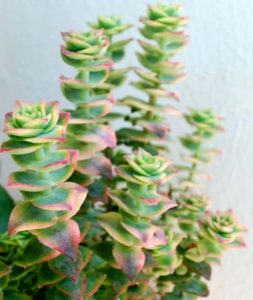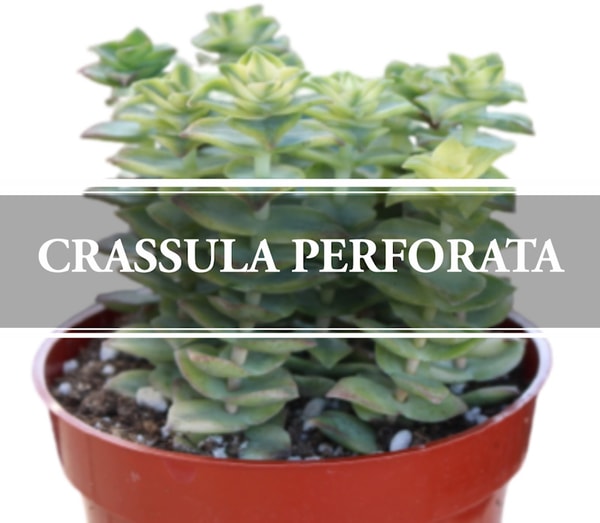A big shout out for another unique succulent! The Crassula perforata belonging to the famous Stone Crop family comes from the Cape Provinces and KwaZulu-Natal in South Africa. A large number of closely grown branchless rambling stems from the plant body. Each stem has a number of greyish-green succulent leaves, looking like small pentagonal beads beaded in a string. Moreover, tiny yellowish flowers grow on clusters in prominently long inflorescences.
These flowers enhance the beauty of the plant on warm days making it look nothing lesser than an eye candy. Don’t think twice before growing them in your gardens, pots, containers, or terrariums. An additional benefit! You can even enjoy this beautiful peep without being an expert or having a green thumb. Isn’t it cool? Let us learn more about the care and maintenance of the Crassula perforata String of Buttons Plant.
Crassula Perforata Classification
Family: Crassulaceae
Genus: Crassula
Specie: C. perforata
Genus Crassula
Crassula is a genus comprising about 200 succulents belonging to the famous StoneCrop family. These plants belong to different regions of the world. Carl Linnaeus was the first to officially introduce this genus in the middle of the 17th century with only 10 species. Howbeit, with researches and progressive studies, botanists kept on adding new members to the genus.
The name ‘Crassula’ means ‘thick’ and belongs to the Latin language. This refers to the thick succulent leaves of these species. Members of this genus are extensively hybridized, the majority of which belong to the South African Eastern Cape.
One of the most popular and common succulents, the Jade Plant( Crassula Ovata) is a proud member of the genus.
Common Names
- Necklace Vine.
- Pagoda Plant.
- The string of Buttons.
Features of the Crassula Perforata Plant

Height
- The plant gets around 45 cm(18 inches) on maturity.
Leaves
- The thick mini triangular-shaped leaves are around 5cm in size.
- These leaves join in alternate patterns on the thick, long and branchless stems.
Flowers
- The plant produces clusters of yellow to cream tiny flowers in the spring and summer seasons.
- The Crassula perforata Flowers enhance the beauty of the plant by blooming on prominently long inflorescences.
Toxicity
- The plant is known to be lower to no toxic at all. However, it is never healthy for kids and pets to chew on or mingle with the houseplants.
Crassula Perforata vs. Crassula Rupestris
These two siblings have close resemblance and people often get confused in differentiating them;
- The inflorescence of the Rupestris plant is dense and round with leaf-like bracts at the base. Moreover, it flowers in the months of June to November.
- On the other hand, the Perforata with its long inflorescence blooms from April to October.
Crassula Perforata Variegata
This variegated form comes with splashes of white shade on the entire foliage. This variegation enhances the beauty of the plant. Howbeit, it is not as common as the original Perforata.
Crassula Perforata Giant
This is a larger form of the Perforata Plant. The structure of both of the plants is pretty similar except for the larger size of the Giant. The plant may get around 2 feet in height having leaves of about 10 cm in size.
Crassula Perforata Care
The Necklace Vine with its beautiful flowers is pretty easy to care. No tricky and time taking demands and quite easy for beginners and all the lazy peeps out there.
Water Requirement
Use the common ‘soak and dry watering technique’ famous for other succulents. Just water the soil generously and let the soil dry out between consecutive watering.
The watering frequency highly depends upon the temperature, humidity, and sunlight availability for the plant. You need to observe the drying period of soil for every season, especially in the beginning. Once you understand the frequency, you can carry on with the understood frequency.
In spring and summer, you need to water about once to thrice a week. On the other hand, about once in seven to fourteen days is enough to keep the succulent alive in the cold days.
Over-watering is a big NO for the succulents. It can cause serious issues like droopy leaves, leaf loss and root rot.
Sunlight Requirement
Medium Shade to the medium indirect sun is ideal for the plant. If you are planting it outdoors, make sure the plant gets at least 6 hours of indirect sun. On the other hand, a window in a well-lit room is a nice place for an indoor peep. People of the Northern hemisphere can simply keep it around a south-facing window.
Direct sunlight is harmful to the delicate leaves. Make sure you don’t let the fierce sun burn out your succulent.
Temperature Requirement
A temperature range of 65 to 80° F is ideal for your String of Buttons Succulent. Just like other members of the genus, these peeps have poor tolerance for cold and frost.
A temperature below 20 °F can freeze and even kill the plant. don’t forget to transfer the plant indoors to some warm spot before it gets ‘cold’ for the plant baby. Moreover, if you are living in an area where the temperature falls below 20 °F, it is better to plant it in a pot or container.
Humidity Requirement
Just like other succulents, it can survive in a range of humidity levels. Howbeit, they flourish well in a moisture level of 50% and above.
Misting the succulents is generally not a very good idea. Keeping the foliage wet for long makes it easy for fungus and other diseases to ‘grab and beat’ your plant peep.
Soil Requirement
The Crassula perforata String of Buttons needs to be in well-draining soil. Peat moss and succulent mixture in equal ratios make a good growing mixture. Moreover, you can also use a cactus mix, which is easily available in markets.
Fertilizer Requirement
Give a monthly dose of common succulent fertilizer in the growing season. Follow the instructions on the pack for the quantity and dosage. Over-fertilizing can dry out and even kill the plant. So, it is better to use lesser than the stated dose, to be on the safe side.
The nutritional requirements of the plants usually decrease in winter and fall. So, make sure you stop providing the extra food before the fall.
Cutting and Pruning Requirements
Just remove the older and unhealthy leaves to enhance the health of the plant.
Growth Zone
The USDA zone 9a is perfect for these succulents.
Crassula Perforata Propagation
Just like other family members, it is also easy-to-propagate. Common methods include;
- Offsets.
- Leaf -cuttings.
- Stem-cuttings.
Season
The warm days of spring and summer are the ideal time for propagation.
Propagation from Offsets
- The plants produce small plants attached to the parent. Take a sterilized knife and cut these Rosette offsets.
- Let them stay for 24 to 48 hours to callous out before you plant them in moist well-drained soil.
Propagation from Leaves
- Twist a few leaves or cut them to separate them from the stem. Just make sure you do a ‘clean-cut’ and no part of the leaf remains on the stem. You can also take full stem cuttings. Just use a sterilized knife to cut a 5 to 7 inches stem from the plant.
- Now, let the cuttings stay for about a day or two. This will allow them to form the callous.
- Simply place them on moist well-drained soil.
- The leaves will root down after about 3 weeks. This will be followed by the shoot development after the 5th week.
Growth Time-Line
Let us have a look at an estimated growth procedure. This will help you to have a better understanding of the propagation of String of Buttons Succulent.
Day 1 to Day 60: Place the setup in a warm and humid place with indirect light of medium intensity. Water the soil mildly with a spray right after it gets about 90% dry. Root and shoot development usually takes place after the 3rd and 5th week respectively.
Day 60 onwards: After the second month, you will see a quickly growing baby Crassula String of Buttons. You can now follow the Crassula perforata Care mentioned in the previous section and enjoy the growth of this beautiful plant. Make sure you gradually increase the quantity of water and not just suddenly ‘flood out’ the new peep.
Summary
Crassula perforata is a succulent belonging to the famous Stone Crop family. It belongs to South Africa and can get about 45cm on maturity. The plant grows with long, branch-less stems attached in alternate patterns. The leaves are small squares in greyish-green in color, look nothing lesser than beads attached to a string. Small yellowish flowers grow in clusters on long inflorescence in the warm days of spring and summer.
You can grow this plant in gardens, containers, pots, or terrariums. Crassula String of Buttons. The houseplant comes with no strict demands or tricky techniques. Indirect light and watering after soil get dry is all you need to keep the succulent happy. Moreover, you can easily make new Perforata plants by planting the offsets or the cuttings of leaves and stems.

